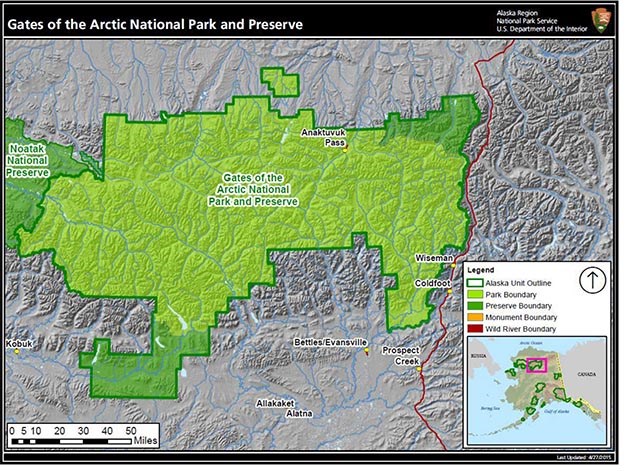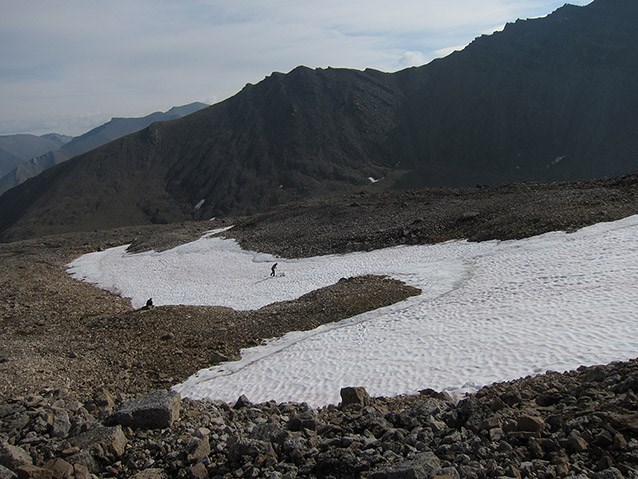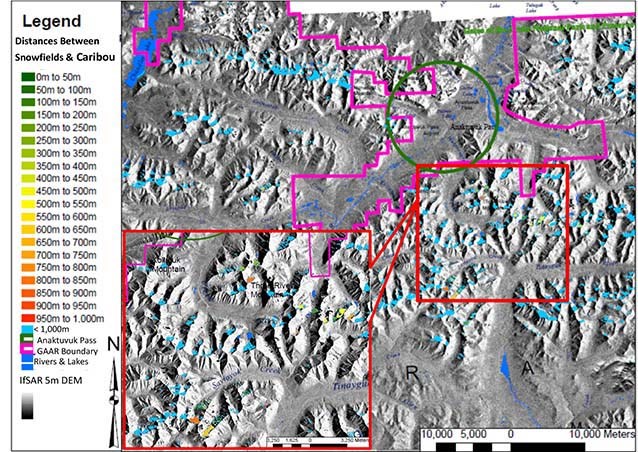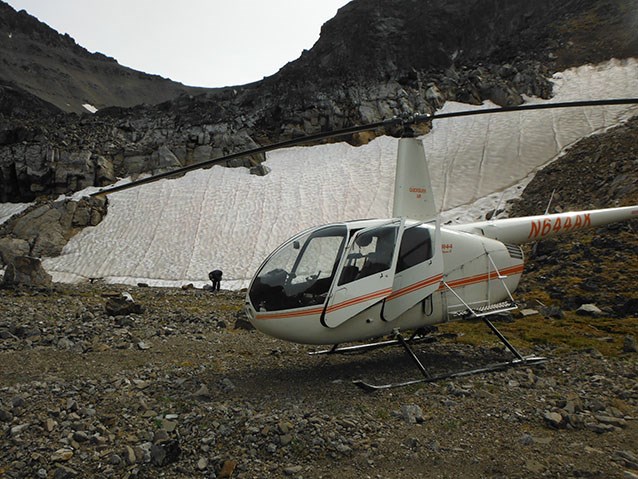Part of a series of articles titled Alaska Park Science - Volume 16 Issue: Science in Alaska's Arctic Parks.
Article
Perennial Snowfields of the Central Brooks Range: Valuable Park Resources
By Molly E. Tedesche, International Arctic Research Center, University of Alaska Fairbanks and Jeffrey T. Rasic, National Park Service
Thousands of years ago, snow and ice in the central Brooks Range of Arctic Alaska might have looked very different than it does today. Glaciers and perennial snowfields (also known as snow patches or ice patches) in what is now Gates of the Arctic National Park and Preserve (Figure 1) were probably much more extensive then than they are now. Perennial snowfields, like glaciers, are masses of snow and ice that persist for many years and form through the accumulation and compaction of snow. However, unlike glaciers, snowfields never grow thick enough to flow with gravity. In modern times, as in the past, caribou herds move to these snowfields in the summer to stay cool and avoid insects (Anderson and Nilssen 1998). Perennial snowfields are also important ecosystems for an array of different bird species (Rosvold 2016). They influence water availability for down-slope vegetation (Lewkowicz and Young 1990) and alter geology (Berrisford 1991) and permafrost (Luetschg et al. 2004).
Thousands of years ago, snow and ice in the central Brooks Range of Arctic Alaska might have looked very different than it does today. Glaciers and perennial snowfields (also known as snow patches or ice patches) in what is now Gates of the Arctic National Park and Preserve (Figure 1) were probably much more extensive then than they are now. Perennial snowfields, like glaciers, are masses of snow and ice that persist for many years and form through the accumulation and compaction of snow. However, unlike glaciers, snowfields never grow thick enough to flow with gravity. In modern times, as in the past, caribou herds move to these snowfields in the summer to stay cool and avoid insects (Anderson and Nilssen 1998). Perennial snowfields are also important ecosystems for an array of different bird species (Rosvold 2016). They influence water availability for down-slope vegetation (Lewkowicz and Young 1990) and alter geology (Berrisford 1991) and permafrost (Luetschg et al. 2004).

Their loss also has the potential to reveal well-preserved archaeological artifacts or ancient animal remains with significant cultural value. Such discoveries have been made in the last decade in snowfields in the southern Yukon (Alix et al. 2012, Hare et al. 2012) and Northwest Territories (Meulendyk et al. 2012) of Canada, and in Wrangell-St. Elias National Park and Preserve (Dixon et al. 2005). Archaeologists think that ancient caribou herds used snowfields in a manner similar to modern herds for insect relief, where ancient hunters tracked them, and sometimes left behind weapons and other tools that became frozen in ice.

Courtesy of Rick Swisher
This was done by combining caribou movement data from the Western Arctic Caribou Herd with a map of snow persistence based on Landsat satellite imagery for Northwest Alaska (Macander et al. 2015). Snowfields in close proximity to places frequented by caribou were then prioritized for field survey based on factors contributing to possible ease of access by ancient hunters, such as gentle slope angles of snowfields and the surrounding terrain.

We surveyed 160 snowfields by helicopter, and conducted visual evaluations for archaeological potential, and location agreement with the extent model. We collected hydrological and biological samples, including water samples, bird remains, and caribou bones and dung. Results of the fieldwork indicate agreement between modeled and surveyed locations of snowfields.

Courtesy Molly Tedesche
The nature of change in perennial snowfields in the central Brooks Range is one of rapid decline, and these changes are of increased significance to the high alpine hydrology and ecology of Gates of the Arctic. Ongoing work will build on the 2015 findings to quantify past perennial snowfield extent and create a snowfield taxonomy that categorizes snowfields with similar physical, topographic, and microclimatic characteristics to predict projected rates of change. Results of this research will help archaeologists continue to target field survey areas, as well as address the impacts that these changes are having on park resources, such as hydrology, vegetation, and wildlife.
Acknowledgements
Chris Ciancibelli, Adam Freeburg, and Kyle Joly were important in planning, field work, and analyses discussed in this article and their help is gratefully acknowledged.
References
Alix, C., P. G. Hare, T. D. Andrews, and G. MacKay. 2012.
A thousand years of lost hunting arrows: Wood analysis of ice patch remains in northwestern Canada. Arctic 95-117.
Anderson, J. R. and A. C. Nilssen. 1998.
Do reindeer aggregate on snow patches to reduce harassment by parasitic flies or to thermoregulate? Rangifer 18(1):3-17.
Berrisford, M. S. 1991.
Evidence for enhanced mechanical weathering associated with seasonally late-lying and perennial snow patches, Jotunheimen, Norway. Permafrost and Periglacial Processes 2:331-340.
Dixon, E. J., W. F. Manley, and C. M. Lee. 2005.
The emerging archaeology of glaciers and ice patches: Examples from Alaska’s Wrangell-St. Elias National Park and Preserve. American Antiquity 129-143.
Evison, L. H., P. E. Calkin, and J. M. Ellis. 1996.
Late-Holocene glaciation and twentieth-century retreat, northeastern Brooks Range, Alaska. The Holocene 6(1):17-24.
Hare, P. G., C. D. Thomas, T. N. Topper, and R. M. Gotthardt. 2012.
The archaeology of Yukon ice patches: New artifacts, observations, and insights. Arctic 118-135.
Hinzman, L. D., N. D. Bettez, W. R. Bolton, F. S. Chapin, M. B. Dyurgerov, C. L. Fastie, and K. Yoshikawa. 2005.
Evidence and implications of recent climate change in northern Alaska and other arctic
regions. Climatic Change 72(3):251-298.
Johannessen, O. M., L. Bengtsson, M. W. Miles, S. I. Kuzmina, V. A. Semenov, G. V. Alekseev, and H. P. Cattle. 2004.
Arctic climate change: Observed and modelled temperature and sea-ice variability. Tellus A 56(4):328-341.
Lewkowicz, A. G. and K. L. Young. 1990.
Hydrology of a perennial snowbank in the continuous permafrost zone, Melville Island, Canada. GeografiskaAnnaler. Series A. Physical Geography 13-21.
Luetschg, M., V. Stoeckli, M. Lehning, W. Haeberli, and W. Ammann. 2004.
Temperatures in two boreholes at Flüela Pass, Eastern Swiss Alps: the effect of snow redistribution on permafrost distribution patterns in high mountain areas. Permafrost Periglac. Processes 15:283-297.
Macander, M. J., C. S. Swingley, K. Joly, and M. K. Raynolds. 2015.
Landsat-based snow persistence map for northwest Alaska. Remote Sensing of Environment 163:23-31.
Meulendyk, T., B. J. Moorman, T. D. Andrews, and G. MacKay. 2012.
Morphology and development of ice patches in Northwest Territories, Canada. Arctic 43-58.
Rosvold, J. 2016.
Perennial ice and snow-covered land as important ecosystems for birds and mammals. Journal of Biogeography 43(1):3-12.
Last updated: December 1, 2020
